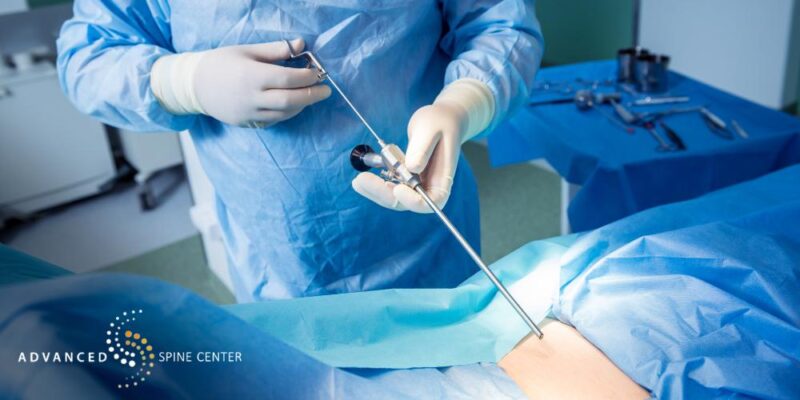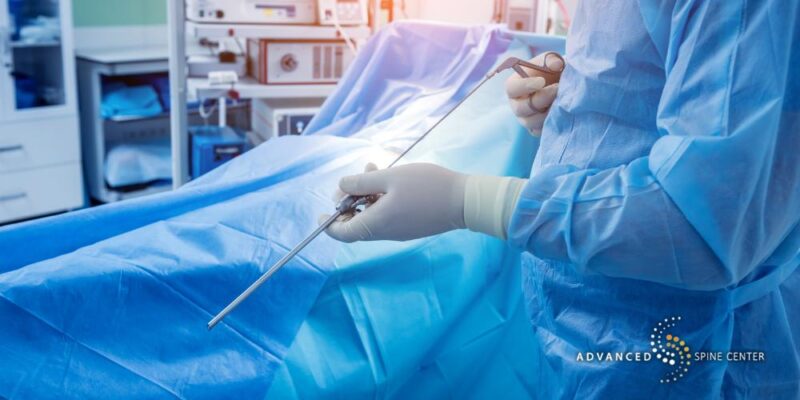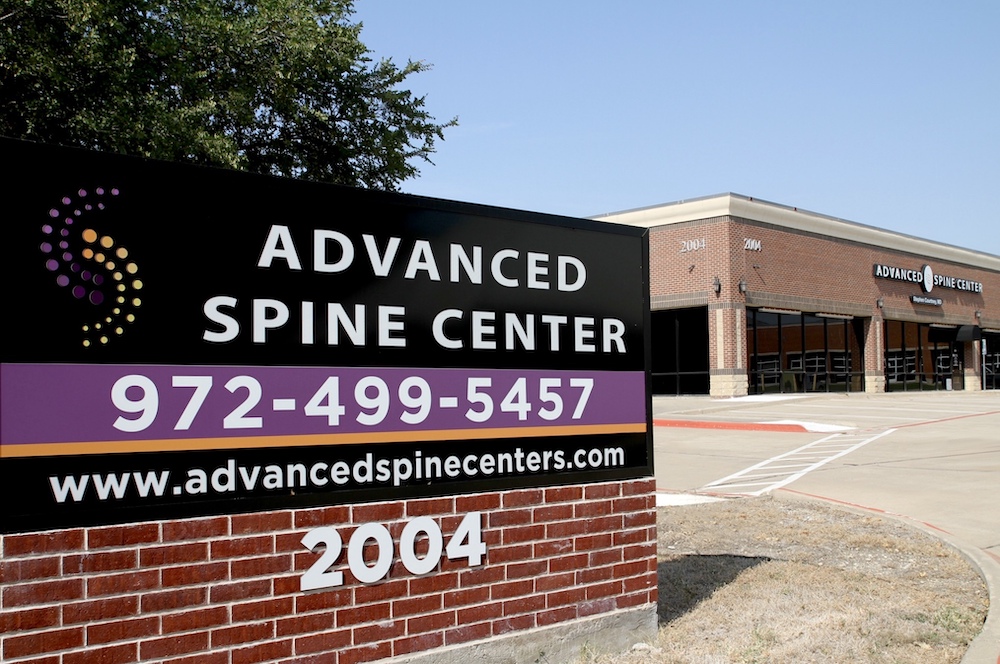Specialties
Lumbar Microdiscectomy Doctor in Plano
To get help with chronic or severe lower back pain, numbness, and tingling, visit the Advanced Spine Center in Plano, Texas. If more conservative treatments have failed to ease your pain, a lumbar microdiscectomy may be the answer you’ve been seeking. With more than 20 years of experience, orthopedic spine surgeon Stephen Courtney, MD, provides lumbar microdiscectomies to relieve pain and discomfort associated with herniated discs.
As a leader in the field and a surgical trainer, Dr. Courtney has the expertise and skill to help you heal. Set up a consultation today to learn about your options by calling Advanced Spine Center at 972-499-5457 or scheduling online.
What Is a Lumbar Microdiscectomy?

A lumbar microdiscectomy is a minimally invasive surgery used to remove a portion of a herniated disc in your lower back. When a herniated disc compresses or irritates a nerve root, it can cause pain, numbness, and tingling in your back and leg. In some cases, symptoms can be felt on both sides of the body.
Lumbar Microdiscectomy vs. Lumbar Discectomy
Microdiscectomy and discectomy are both a form of spine surgery performed to remove parts of herniated discs to relieve the pressure they place on the nerves in the spinal canal. Also called microdecompression, a microdiscectomy involves using minimally invasive techniques to treat lumbar disc herniation. It involves a much smaller incision than a traditional open discectomy and is an outpatient procedure.
Open discectomies are effective techniques for removing herniated disc material to relieve pressure on spinal nerve roots. However, they have certain disadvantages compared to microdiscectomy surgery. A traditional lumbar discectomy would need the following, while a microdiscectomy would not.
- Longer operation time
- Larger incision
- Longer recovery time in hospital and at home
- More anesthesia
- Muscle dissection
The main difference between the two techniques is that microdiscectomy is a minimally invasive surgery that involves small tools, like endoscopes. By using modern tools and techniques, the result of microdiscectomy is a faster, less painful, and less damaging procedure.
Lumbar Microdiscectomy vs. Lumbar Spinal Fusion
The common denominator between lumbar microdiscectomy and lumbar spinal fusion is the removal of herniated disc material. However, spinal fusion involves the removal of an entire disc, while microdiscectomy may only remove part of a disc. Additionally, lumbar spinal fusion is a spinal surgery that fuses two or more lumbar vertebrae together.
Both surgeries aim to relieve spinal nerve root pain, but in different ways. Depending on a patient’s source of pain, condition, and individual needs, one of the two surgeries may be recommended as a treatment for lower back pain.
Lumbar Microdiscectomy vs. Lumbar Injections
Microdiscectomy is a surgical procedure that removes part of a herniated disc to treat back pain. Lumbar injections are not a form of surgical treatment. Instead, they involve carefully administering pain medicine and, often, steroids to the affected back area. Spinal injections are often recommended as a conservative treatment before surgery.
What Are the Benefits of a Lumbar Microdiscectomy?

If you suffer from lower back pain, leg pain, muscle weakness in the lower extremities, or sciatica, you may benefit from lumbar microdiscectomy. This spine surgery has several benefits over traditional open surgery, including the following.
- Significant pain relief: One of the primary reasons for undergoing a lumbar microdiscectomy is to relieve pain. By removing the portion of the herniated disc that is compressing spinal nerves, this procedure can significantly reduce or eliminate lower back pain and radiating leg pain (sciatica).
- Minimally invasive: Lumbar microdiscectomy is considered a minimally invasive surgical procedure. It involves smaller incisions, less disruption to tissues surrounding the spinal cord, and reduced muscle trauma compared to traditional open back surgery. This typically results in less post-operative pain.
- Shorter hospital stay: Most patients can undergo the procedure as an outpatient and return home the same day or the day after surgery. This minimizes the need for an extended hospital stay.
- Faster recovery: Recovery time for lumbar microdiscectomy is often relatively short compared to open back surgery. Patients can typically resume light activities and return to work within a few weeks, although the exact timeline can vary depending on individual factors.
- Lower risk of complications: The minimally invasive nature of the procedure typically results in a lower risk of complications compared to open surgery. The smaller incision reduces the risk of infection and scarring.
- High rate of success: Lumbar microdiscectomy has a high success rate in providing relief from symptoms associated with lumbar disc herniation. It is generally effective in alleviating leg pain, numbness, tingling, and weakness caused by nerve compression.
When Is a Lumbar Microdiscectomy Recommended?
If a patient has tried more conservative treatments for a lumbar disc herniation and experienced no pain relief, microdiscectomy may be recommended. A microdiscectomy is performed on herniated discs that are causing any of the following symptoms:
- Lower back pain
- Sciatica
- Severe pain
- Functional impairment
- Progressive neurological issues
- Numbness and tingling in the leg or foot
- Muscle weakness in the leg or foot
- Sharp, shooting pain in the buttock, thigh, or leg
Dr. Courtney will recommend a microdiscectomy if you have tried other conservative and minimally invasive treatments, including physical therapy, lifestyle modifications, and lumbar injections, without success.
What Conditions Does a Lumbar Microdiscectomy Treat?
Broadly speaking, microdiscectomy treats conditions that put pressure on the spinal nerves, causing pain, numbness, tingling, and muscle weakness in the lower back and extremities. Specific conditions that can benefit from microdiscectomy include the following.
- Lumbar radiculopathy
- Foraminal stenosis
- Sciatica
- Lumbar disc herniations
- Bulging lumbar discs
It’s important to note that a lumbar microdiscectomy is a targeted surgical procedure designed to address specific nerve compression issues related to lumbar disc problems. It is not a treatment for other spinal conditions, such as degenerative disc disease or spinal stenosis affecting multiple levels of the spine. The decision to undergo a lumbar microdiscectomy is typically based on a careful evaluation of the patient’s condition, medical history, and the specific nature of the disc-related symptoms.
How to Prepare for Lumbar Microdiscectomy

Before undergoing your microdiscectomy surgery, Dr. Courtney will go over how to prepare both your home and your body for surgery. To prepare your body and reduce the risk of complications, your doctor may ask you to do the following.
- Stop smoking and drinking alcohol
- Stop taking medications that thin the blood
- Refrain from eating or drinking for a certain amount of time before the surgery
- Change the dosage on certain medications
Remember that you should not alter your medications or stop taking them unless your doctor asks you to do so. Dr. Courtney will review your current medications and let you know if you need to make any changes.
You’ll also need to prepare your home to help make your recovery easier. We recommend taking the following steps to prepare your home for postoperative recovery.
- Cook or buy meals in advance and have them ready to heat up
- Place all essential items in easy-to-reach places to avoid bending down or reaching for them
- Make sure to stock your groceries and toiletries before your surgery so you won’t have to go to the store
- Arrange for someone to drive you home from the surgery, as you won’t be able to drive
- Have someone help you around the house for the first two or three days after surgery
Is Lumbar Microdiscectomy a Major Surgery?
A minimally invasive lumbar discectomy (microdiscectomy) is not a major surgery in the sense that open spine surgery is. Although it is a surgical procedure, it involves very small incisions and very small tools for as little tissue disruption as possible. As a treatment for lumbar disk herniation, it only removes some of the damaged tissue. To reiterate, microdiscectomy is a minor surgery that involves much smaller incisions and a much shorter recovery time.
How Is a Lumbar Microdiscectomy Performed?

A microdiscectomy is an outpatient procedure that takes 1-2 hours. Dr. Courtney uses minimally invasive discectomy techniques and general anesthesia during the procedure, so you are asleep and experience no discomfort.
Once you are comfortable and the anesthesia has taken effect, Dr. Courtney makes a small skin incision about 1-1½ inches in length in your back. He places a thin guide wire through this incision to reach the surgical site.
Using fluoroscopy to guide the treatment, Dr. Courtney precisely inserts a thin tube called a dilator to carefully push surrounding muscles out of the way without cutting them. This allows him to access the affected intervertebral disc.
Once the dilator is in place, Dr. Courtney removes the guide wire and inserts small surgical tools through the dilator to do the surgery. He carefully removes the herniated disc material that is irritating the nerve before removing the surgical instruments and applying a bandage to your back.
Dr. Courtney uses the dilator tube because it allows him to perform the surgery without cutting or disturbing surrounding muscles. This technique helps you heal faster and with less pain than traditional open surgeries.
Surgical Approaches for Microdiscectomy in the Lumbar Spine
Microdiscectomy uses minimally invasive techniques to access and remove herniated disc tissue to relieve pressure on the spinal nerve root. As with most surgeries, there are multiple possible approaches a surgeon can take to reach the area to be treated. Below, we describe two common microdiscectomy techniques.
Tubular Microdiscectomy
In a tubular microdiscectomy, the surgeon separates the muscles instead of cutting them. This is done by using serial dilators. Dr. Courtney uses the tubular technique because of its minimal damage to the tissues surrounding the treatment area.
Percutaneous Endoscopic Lumbar Discectomy
The term “percutaneous” means to perform surgery through a small puncture instead of a larger incision. Once the needle is guided to the treatment area, it is replaced by a small tube through which an endoscope is fed. The surgeon performs the surgery through an opening in the endoscope while watching the feed from the endoscopic camera.
What Is the Recovery Process After a Microdiscectomy?
After you’ve recovered in the hospital for a few hours, you can return home to heal. Dr. Courtney provides extensive aftercare instructions about keeping the surgical site clean and taking pain-relieving medications as needed. You’ll follow up with Dr. Courtney within 1-2 weeks for evaluation.
After surgery, you will likely feel stiff or sore around the incision site. This discomfort will gradually improve. Many patients experience immediate relief from their pre-surgery symptoms, while others experience gradual relief.
In the weeks following surgery, you will likely feel discomfort after sitting or standing for too long. It is normal for patients to need pain medicines to manage their postoperative pain. You will work with a physical therapist to restore strength and range of motion to your back. Expect to recover for at least 8 weeks before returning to your normal activities.
While caring for yourself at home, it’s important to take the following steps.
- Properly care for your incision by keeping it clean and dry and following your doctor’s instructions
- Take medications as instructed by your doctor
- Drink plenty of fluids
- Rest when you feel tired, but try to walk a little each day
How Painful Is a Lumbar Microdiscectomy?
The level of pain experienced during and after a lumbar microdiscectomy can vary from person to person, and several factors can influence the perception of pain. During surgery, you should feel no pain due to general anesthesia.
Immediately after surgery, patients may experience some discomfort or pain at the surgical site as they begin to wake up from anesthesia. This pain is usually managed with medications administered by the medical team.
Once patients return home, they may experience varying levels of pain or discomfort at the surgical site, which is common after any surgical procedure. This pain is often described as soreness, stiffness, or mild to moderate discomfort. It can be managed with prescribed pain medications, which are typically taken as directed by the surgeon.
The pain experienced during the recovery period can vary. Some patients may find that they experience relatively mild discomfort that improves steadily over a few days to weeks. Others may have more significant discomfort, particularly when performing certain movements or activities. The severity and duration of post-operative pain can depend on factors such as the patient’s overall health, the complexity of the surgery, and their individual pain threshold.
What Is the Expected Recovery Time for Microdiscectomy?

Most patients feel well enough to return to work after a two-week recovery period. However, they will still need to keep their activity levels low. For at least 6 weeks, patients should modify their activity to put as little strain on their back as possible. Physical therapy will usually begin around week two or three, and patients can expect to return to normal activities after about 8 weeks.
What Are the Risks and Complications of a Lumbar Microdiscectomy?
As with any surgery, lumbar microdiscectomy has certain risks and complications. Although complications are rare, it is important for patients to understand these risks before undergoing the surgery. The potential risks and complications of microdiscectomy include the following.
- Nerve damage
- Recurrent herniation
- No relief from pain, weakness, or numbness
- Severe pain
- Bleeding problems
- Infection
- Blood vessel damage
- Incontinence
- Deep vein thrombosis
- Failed back surgery syndrome
All this being said, the success rate for lumbar microdiscectomy is generally high. Several studies have shown that around 80% of patients return to work within 12 weeks of their surgery.
Contact the Advanced Spine Center for Lumbar Microdiscectomy in Plano, TX
If you are suffering with pain from a herniated lumbar disc, we recommend contacting an orthopedic surgeon specializing in spine care. Spine surgeons, like Dr. Courtney, have extensive experience treating conditions that cause lower back pain. To schedule a microdiscectomy consultation with Dr. Courtney, call Advanced Spine Center at 972-499-5457 or book online now.


